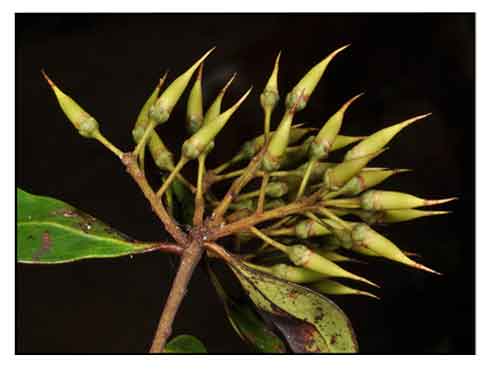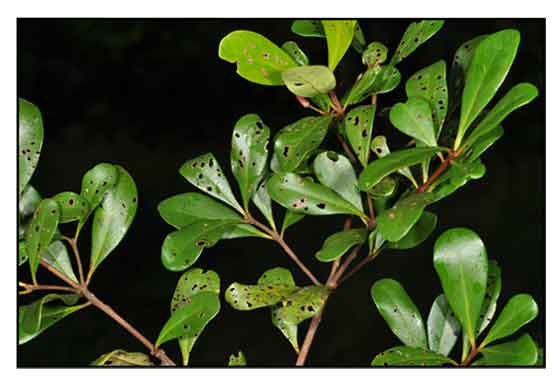
Family • Primulaceae
Tinduk-tindukan
Aegiceras floridum Roem. & Schult.
BLACK MANGROVE
La zhu guo
| Scientific names | Common names |
| Aegiceras ferreum Blume | Katuganung (Bis.) |
| Aegiceras floridum Roem. & Schult. | Kwasay (Bis.) |
| Aegiceras nigricans A.Rich. | Saging-saging (Tag.) |
| Tinduk-tindukan (Tag.) | |
| Tundok (Tag.) | |
| Black mangrove (Engl.) | |
| Goat's horn mangrove (Engl.) | |
| Northern river mangrove (Engl.) | |
| River mangrove (Engl.) | |
| Aegiceras floridum Roem. & Schult. is an accepted name. KEW: Plants of the World Online | |
| Some compilations list Aegiceras corniculatum as a synonym of A. floridum. Most list them as separate species. | |
| Other vernacular names |
| BENGALI: Khalsi. |
| CHINESE: La zhu guo. |
| HINDI: Halsi. |
| MALAY: Kacang-kacang, Kuku helang, Teruntum. |
| MALAYALAM: Karinjikkata. |
| MARATHI: Kajala. |
| VIETNAMESE: Su thang. |
Botany Distribution
Properties Studies Availability |
Updated October 2024
August 2022
![]()
 |
PHOTOS / ILLUSTRATIONS |
| IMAGE SOURCE: / Photo: Primulaceae: Aegiceras floridum: Infructescencer / @ Copyright © 2014 by P.B. Pelser & J.F. Barcelona (contact: pieter.pelser@canterbury.ac.nz) [ref. DOL90275] / click on image to go to source page / Phytoimages.siu.edu |
| OTHER IMAGE SOURCE: Photo: Primulaceae: Aegiceras floridum: Twig / @ Copyright © 2012 by P.B. Pelser & J.F. Barcelona (contact: pieter.pelser@canterbury.ac.nz) [ref. DOL48580] / click on image to go to source page / Phytoimages.siu.edu |
Additional
Sources and Suggested Readings |
• |
DOI: It is not uncommon for links on studies/sources to change. Copying and pasting the information on the search window or using the DOI (if available) will often redirect to the new link page. (Citing and Using a (DOI) Digital Object Identifier) |
| List of Understudied Philippine Medicinal Plants |
| New plant names needed The compilation now numbers over 1,500 medicinal plants. While I believe there are hundreds more that can be added to the collection, they are becoming more difficult to find. If you have a plant to suggest for inclusion, native or introduced, please email the info: scientific name (most helpful), local plant name (if known), any known folkloric medicinal use, and, if possible, a photo. Your help will be greatly appreciated. |
• |
 |

 Gen info
Gen info Constituents
Constituents